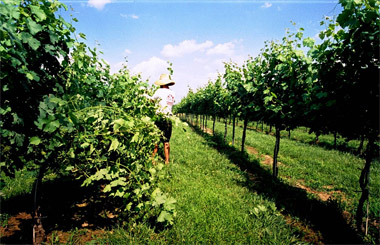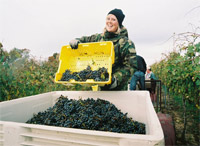
Divided, they stand -- In a vineyard on the campus of Southern Illinois University Carbondale, graduate student Sean M. Lynch trains grapevine leaves to grow in different directions so all will receive more light. Such “divided canopy” management produces more grapes and can increase the net return by close to $4,000 per acre. (Photos provided courtesy of H. Bradley Taylor) Download Photo Here
February 04, 2009
SIUC continues efforts to assist grape industry
CARBONDALE, Ill. -- The Illinois Grape and Wine Resources Council may be history, but Southern Illinois University Carbondale hasn’t closed the book on grape research.
Work ongoing at University vineyards includes variety evaluations, ground cover management research and studies of viruses and nematodes that prey upon the crop. Outreach efforts include demonstrations of training systems and canopy management practices to help boost grower revenues.
“We have developed significant new areas of inquiry to define and solve problems that we see developing throughout the state while carrying on with and evolving some of the older projects,” said Bradley H. Taylor, the College of Agricultural Science’s fruit specialist.
These days, variety evaluations play a key role in Taylor’s research as he looks for those that can stand up to harsh Midwestern winters while producing high-quality fruit year after year.
“This is critical for an industry where it takes five to seven years to get appreciable revenue, especially when you’re investing $10,000 per acre -- not including the cost of the land,” Taylor noted.
“Oftentimes, you will have to order a specific variety several years in advance of planting. It’s almost a decade from the time you make your decision to the time you have the opportunity for net revenues, so you want to know you will have 15 to 20 years of top-quality, reliable production from the varieties you select.”
Taylor is assessing the vigor, adaptability, yields and fruit quality of 35 different varieties, including French hybrid and European grapes. It’s a balancing act. The French hybrid grapes show good winter hardiness, but the quality is not always quite what he’d like to see. The European varieties do well on quality indicators but suffer more from sub-freezing temperatures (those from 5 degrees to 8 below zero), though that might present less of a problem for growers in Southern Illinois, where winters tend toward mildness.
Taylor also is looking at groundcovers that could suppress perennial and annual weeds beneath the vines, thus cutting money spent on herbicides and time spent mowing. But groundcovers could possibly do even more in terms of keeping the vines themselves in check.
Surprisingly, vines that grow too well spell trouble for the grapes. By shading the fruit zone, they boost the chances that fungi and other diseases will thrive. And without enough sunlight, the grapes don’t produce the pigments and aromatic compounds that flavor the fruit. It’s also harder to manage the acidity levels of shaded grapes during the winemaking process, which not only can dull the flavors but actually impart an unpleasant taste to the finished wine.
“In Illinois, which is noted for ground that can yield 150 to 250 bushels of corn per acre, it’s easy to get shoots that grow 6 to 8 feet in a single season rather than the 3 to 4 feet that’s ideal,” Taylor said.
“One shoot on my vines grew 23 feet, though that’s not the average. We’ve found the right groundcover can reduce excessive vigor by 20 to 25 percent. Our experiments have also shown that dividing the canopy can also help manage excessive vine vigor while improving wine flavor and structure.”
Perhaps most critical for long-term production is the work Taylor is doing to minimize damage to grapevines from viruses and nematodes (small, root-sucking pests afflicting a variety of crops, in this region most notably soybeans).
“Most viruses and nematodes don’t start expressing themselves for four to seven years after planting, which could be devastating to cash flow,” Taylor said. “You just get to the point where you have your first good crop, and then your vines start to decline.”
Taylor has also continued work done by Imed Dami, the council’s former viticulturist based at SIUC, particularly as it related to research and service activities.
“Within the last year we’ve had more than 530 hours of contact with grape growers through presentations across the state,” Taylor reported. Presentations and demonstrations covered such diverse topics as pruning methods, coping with freeze damage and production marketing.
“It’s important that folks know our involvement in assisting the grape industry never diminished, despite the changes in personnel and funding structure (that occurred when the council closed its doors in 2004),” Taylor said. “It just changed form.”

